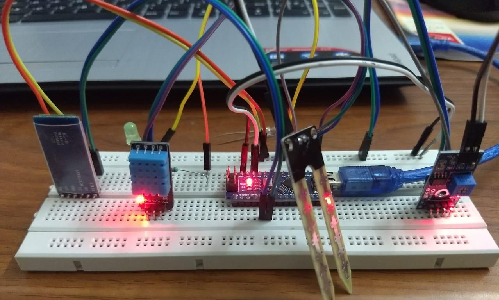A young engineering student develops a smart device to measure soil moisture, farm temperature and even regulate irrigation based on those parameters. The microcontroller-based Smart Plant Monitoring System can be operated remotely from anywhere and can come handy for scientific irrigation.
Ahmedabad (ISJ) – An Indian engineering student has developed a cost-effective smart device, which can revolutionise water-starved farm sector in the country. The Smart Plant Monitoring System can measure the soil moisture, temperature in the field and regulate irrigation, based on those parameters.
The microcontroller-based device can also communicate with the operator manually on phone or PC through Bluetooth or WiFi network over internet, so that he could get to know the real-time conditions in the farm like temperature, humidity and soil moisture from anywhere, anytime.
“The system can control the flow of water to large section of plants or crops in agricultural fields with accurate amount of its daily irrigation need. It can be further used to know the temperature and humidity around the plant to estimate the weather conditions, which could indicate the probability of rain conditions,” Aniruddh Sharma, a mechanical engineering student at Ahmedabad-based Institute of Infrastructure Technology Research & Management told Indian Science Journal.
The microcontroller, Arduino Nano is programmed with software Arduino IDE according to specific requirement that commands the microcontroller to process signals received from soil moisture sensor (which is put under soil) and DHT11(Temperature and Humidity of surrounding) and decides to start or stop the pump for water in the field. Along it, the microcontroller also sends the information taken from the sensors through Bluetooth module to a mobile application.
Depending on the size of the farm, more sensors have to be calibrated. Each Soil Moisture Sensor can cover an area of 1000 Sq. Ft, said Sharma. He said the system receives data on water level from different moisture sensors and decides the water flow to different parts of the field. It can be operated remotely from anywhere through internet.
Sharma said, the Bluetooth Module is accessible from 9 metres, while the WiFi Module can be accessed from a distance of 400 metres, in ideal conditions. The data can also be accessed through a Cloud Server and the operator can access and operate the system from anywhere.
The device works on a power source of 9V battery or direct power through an adapter of 12V to microcontroller and one channel, 5V 10A Relay Module to control the water pump or motor and Bluetooth or WiFi Module. The estimated cost of the device is between Rs. 800 to 1000, whereas devices available outside India costs 100 US dollars, or between Rs. 6500-7000.
Sharma has already done limited field trials and now plans to improve upon it, based on his experience, for commercial use.
With the decrease in landholdings and erratic climate changes, farming in India is facing many challenges. A major share of agriculture still depends on monsoon for irrigation, and thus Indian agriculture is called “a gamble in the monsoon”.
Unless farmers shift to scientific methods, they cannot expect to increase production and minimise expenditure. Deployment of sensors for monitoring soil’s quality and irrigation would help in improving the quality and quantity of the crops.


